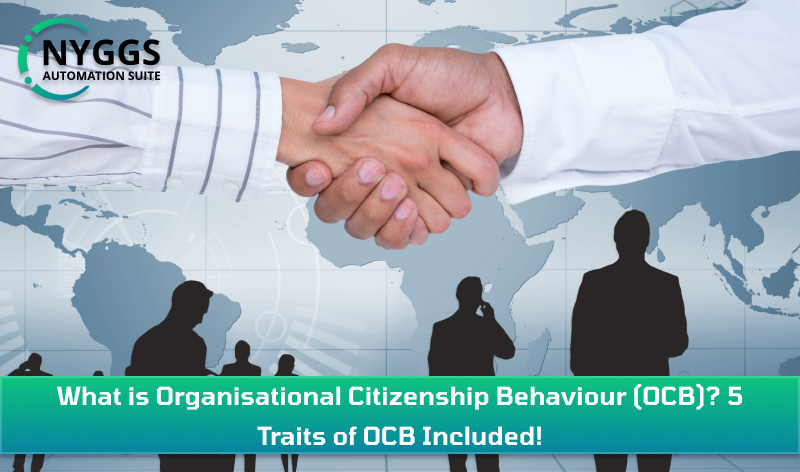What would you call it when an employee selflessly goes the extra mile, supporting his/her colleagues without expecting anything in return? There’s a term for this remarkable trait known as Organisational Citizenship Behaviour or OCB. It’s not just a term; it’s a concept that holds the key to unlocking the power of a positive, productive, collaborative and harmonious work environment. So, let’s discuss what OCB means and its composition.
What is Organisational Citizenship Behaviour?
Organizational Citizenship Behaviour, or OCB, may not be a term that many of us are familiar with. But don’t worry. We are here to walk you through the most important traits of OCB. OCB means the positive actions or activities that are not in your responsibility parameters, but you do them voluntarily beyond your formal job descriptions. In short, it refers to the deeds done with the aim of aiding others.
Here are a few examples for better understanding:
- You are helping your colleagues finish a project, even though you have your own work to do.
- A manager organizes a potluck lunch for their teams, even though it’s not part of their job description.
- A retail employee volunteers to work an extra shift to help their team out.
These are just a few examples of OCBs. There are many other ways that employees can go above and beyond their job duties to help their organization and their colleagues.
However, understanding OCB is important, specifically in the context of promoting employees’ morale and workplace dynamics. These qualities are inbuilt traits of some individuals. Moreover, encouraging OCB among employees can promote a positive work environment and significantly impact the organization’s effectiveness.
Now, let’s discuss the categories of OCB.
What are the 5 traits of Organisational Citizenship Behavior?
Organisational Citizenship Behaviour is made up of five major types. Although, there are several components of OCB, each with its own set of features. But, here, we discuss the primary components that comprise the frame of OCB.
Let’s go over each of its five types.
Altruism
When a person decides to help another without expecting anything in return, this is referred to as altruism or selflessness. Fortunately, altruism is contagious, and it inspires others to act altruistically as well.
For Example: Offering childcare to your neighbor’s children so they may go to work without expecting anything in return. Or helping a co-worker to complete a project report he/she is dealing with.
Moreover, in the workplace, altruism provides numerous advantages. It can improve your general psychological state, resulting in a phenomenon known as “helper’s high.” When we help others or perform acts of kindness, it triggers the pleasure hormones in our brains. It is a human tendency to get a feeling of happiness and satisfaction when we help others without any expectation.
Civic Virtue
Activities centered on promoting the company’s interests in which employees volunteer to participate in functions or serve on committees. In simple words, when employees represent their organization in a good way both on and off the job.
Examples: Participating in a blood donation event on behalf of your company. Or, volunteering to teach kids who don’t have access to general education.
Conscientiousness
Going above and beyond official duties to ensure that the organization’s resources are used efficiently and any potential problems are identified and resolved. Arriving early, leaving late, and doing more than your responsibilities are all indications of conscientiousness.
Examples: A content writer who ensures that fuzzy graphics do not appear in a sales brochure.
Or, arriving at the office early for the purpose of preparing for a client meeting.
Sportsmanship
Being generous in terms of devoting extra time and effort to the organization’s endeavors, being a team player, and showcasing team spirit. Sportsmanship occurs when an employee chooses to remain positive in the face of bad decisions or difficult circumstances.
Examples: Ensuring that a colleague receives due recognition for any good work that may have gone negligible. Or, as a leader, it means owning up and taking responsibility if a project doesn’t succeed, even if it wasn’t your fault.
Courtesy
Being kind and considerate to colleagues, responding positively to their requests, and expressing gratitude for their efforts and contributions. In simpler terms, when a co-worker is friendly and considerate toward their colleagues, it’s a display of courtesy. This means they’re polite and respectful, and go out of their way to create a positive and harmonious work environment.
Examples: Being respectful and mindful to someone who is your subordinate but older than you. Or, being patient with a co-worker when you know they are struggling with any kind of personal issue.
Conclusion
In this blog, we’ve explored what OCB means and its related components! Promoting these qualities among employees is significant in today’s competitive business world. It may take your organizational effectiveness ahead of your competitors. Additionally, by creating a healthy work environment, you can impose a positive aura on the surroundings. Moreover, it aids co-workers to motivate each other which ultimately leads to a workspace with high productivity. In essence, Organisational Citizenship Behaviour can have an invaluable impact on the morale of the employees that sustains them forever.
Frequently Asked Questions
Q. What does an OCB mean?
Ans. OCB means the positive actions or activities that are not in your responsibility parameters but you do them voluntarily beyond your formal job descriptions.
Q. What are the components of OCB?
Ans. The key components of Organisational Citizenship Behaviour include
- Altruism
- Conscientiousness
- Sportsmanship
- Civic Virtue
- Courtesy
Q. Why is promoting OCB among employees essential for businesses?
Ans. Promoting OCB among employees is essential because it enhances organizational effectiveness, sets a positive work environment, motivates co-workers to support each other, and ultimately leads to higher workplace productivity.


